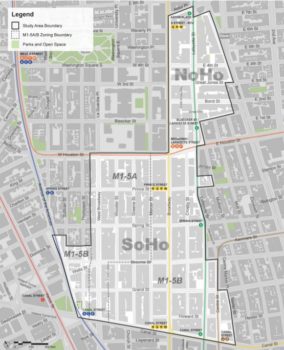
Map from the Envision SoHo-NoHo Report. Image Credit; Envision SoHo/NoHo/ NYC Planning
On October 7, 2020, Mayor de Blasio announced that the SoHo/NoHo Neighborhood Plan will advance to the City’s public land use review process. The purpose of the Neighborhood Plan is to expand housing opportunities for New Yorkers, support cultural and economic success in the area, and reduce regulatory burdens on residents and workers in the area.
SoHo and NoHo are currently regulated by 50-year old zoning that prohibit housing and prioritize the space for industrial use. The proposal would modernize the area’s zoning and establish a new zoning district with housing and vibrant spaces dedicated to culture and the arts. The area will include Houston Street and Astor Place to the north, Canal Street to the south, West Broadway to the west and Lafayette Street and the Bowery to the east.
This Neighborhood Plan began with a six-month SoHo/NoHo Planning Process in 2019 sponsored by the Manhattan Borough President’s Office, Council Member Margaret Chin’s Office, and the Department of City Planning. During the community planning process, local residents, business owners, and other community members participated in over 30 discussions and gave their recommendations and priorities for the neighborhood. Learn more about the planning process here.
The Plan will create two housing neighborhoods, with as many as 3,200 new homes. Additionally, 800 of these units will permanently affordable homes, in furtherance of the priorities developed under Where We Live NYC, the City’s fair housing planning process. Where we Live NYC ensures every neighborhood in the City contributes to the City’s affordable housing goals, especially disproportionately white areas such as SoHo and NoHo. The proposal would also allow a wider range of commercial uses, and support live-work and arts and cultural spaces.
The first step to prepare for the public review process – the notice of the scoping hearing – will be released this Friday, and the remote public scoping meeting will be held on November 10, 2020. As stated in the press release, the formal certification into the public review process is anticipated in 2021. The certification will kickstart the ULURP timeline in which community boards, the Borough President, the City Planning Commission, and City Council all have to hold public hearings and review the application.
Mayor de Blasio stated, “New York City has changed a lot in the last fifty years, and SoHo and NoHo have changed with it. Thoughtful, progressive zoning changes will pave the way for the next fifty years of growth – while making two iconic neighborhoods more accessible than ever, and helping us rebuild a fairer and better city.”
James Patchett, president and CEO of New York City Economic Development Corporation, stated, “Investments that support our small businesses and make our city more equitable are key to a robust economic recovery that builds a stronger future for New York City. This proposed zoning initiative creates more affordable homes for New Yorkers, removes barriers to local businesses, and builds a more inclusive city. It is the vision we need to prioritize as the City looks towards the future and the recovery that lies ahead.”
Cultural Affairs Commissioner Gonzalo Casals stated, “By transforming industrial buildings into live/work space and advocating to preserve the area in the 1970s, Soho’s storied artist community helped put New York on the map as a global arts capital. We look forward to working with local leaders, residents, and other stakeholders to re-imagine how this iconic neighborhood can nurture a vibrant cultural community as it continues to evolve.”
By: Victoria Agosta (Victoria is the CityLaw intern and a New York Law School student, Class of 2022.)


If passed, this upzoning has the potential to be the first, albeit small, real step in slowing gentrification and reducing overall displacement citywide.